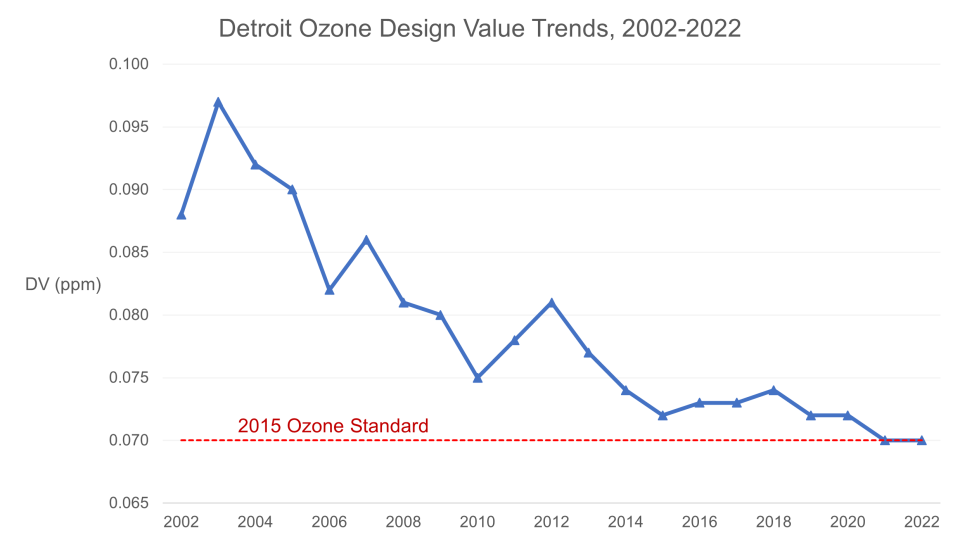EPA Finalizes 2015 Ozone Standard Redesignation to Attainment for the Detroit Area
On this Page:
- Redesignation to Attainment
- Public Comments
- Background
- Clean Data Determination
- Additional Resources

EPA is finalizing a redesignation to attainment for the metro Detroit 8-hour ozone nonattainment area, concluding that the area attained the 2015 8-hour National Ambient Air Quality Standard (NAAQS) for ozone. The redesignation is based on certified 2019-2021 data showing an ozone design value of 0.070 parts per million (ppm), which is the threshold for an attainment determination. The Detroit area, including Livingston, Macomb, Monroe, Oakland, St. Clair, Washtenaw, and Wayne counties, shows continued attainment of the standard with a 2020-2022 ozone design value of 0.070 ppm.
EPA is also finalizing approval of the Michigan Environment, Great Lakes, and Energy’s (EGLE) maintenance plan to ensure that the area will continue to meet the 2015 ozone standard through 2035. The EPA-approved maintenance plan for the area also includes contingency provisions which require EGLE to implement additional control measures if the area violates the ozone standard in the future, in order to bring the area back into attainment.
The resignation request was made using the most recent data set at the time of submittal, 2019-2021. In a separate action EPA finalized a Clean Data Determination for the 2020-2022 data set. See Additional Resources for for information on the final rulemaking for the clean data determination for the Detroit metro area to attainment of the 2015 ozone NAAQS.
Public Comments
A 44-day comment period was open from March 14, 2022 through April 27, 2022. EPA’s response to public comments is addressed in the final rulemaking.
Background
The air quality data now shows that the Detroit area meets the federal ozone standard. The Clean Air Act (CAA) allows redesignation of an area to attainment of the NAAQS provided that:
- EPA determines that the area has attained the relevant NAAQS;
- EPA has fully approved the applicable implementation plan for the area under section 110(k) of the CAA;
- EPA determines that the improvement in air quality is due to permanent and enforceable reductions in emissions;
- EEPA has fully approved a maintenance plan for the area as meeting the requirements of section 175A of the CAA; and
- the state containing the area has met all other requirements applicable to the area for the purposes of redesignation under section 110 and part D of the CAA
A detailed description of how the Detroit area meets the CAA requirements for ozone nonattainment area redesignations to attainment, including a plan for continued attainment of the standard, is provided in the notice of proposed rulemaking. Although this redesignation is related to EPA’s clean data determination based on 2020 to 2022 data, regarding the data set used for regulatory purposes, EPA proposed that action and responded to public comments in that final rulemaking.
On October 1, 2015, EPA strengthened the level of the NAAQS for ozone from 0.075 ppm to a more protective 0.070 ppm. Ground-level ozone is not emitted directly into the air but is formed when nitrogen oxides (NOx) and volatile organic compounds (VOCs) react in the presence of sunlight. Emissions from industrial facilities and electric utilities, motor vehicle exhaust, gasoline vapors, and chemical solvents are some of the major sources of NOx and VOCs. Reducing ozone will help people to experience fewer health problems including chest pain, coughing, throat irritation and congestion. Less ground-level ozone will also help to avoid worsening conditions such as bronchitis, emphysema, and asthma, and it will help to avoid reducing lung function or inflaming the linings of the lungs. Children will especially benefit from reduced exposure to ozone because their lungs are still developing.
As shown in the graph below, ozone in the Detroit area has declined significantly over the last 20 years. The most recent design value, based on 2020-2022 data, is attaining the standard with a design value of 0.070 ppm. The improvement in air quality is due to state and EPA programs that reduce NOx and VOC emissions. These control measures include more protective vehicle emissions standards, nonroad engine emissions standards, and programs to reduce emissions from power plants. Nationally, average concentrations of ozone decreased 20% from 2000 to 2020. For the Detroit area, the past twenty years have seen a 28% decrease in ozone concentrations, with additional emission reductions expected to occur in the future.

- Notice of Proposed Rulemaking – Redesignation to Attainment
- Notice of Final Rulemaking – Redesignation to Attainment
